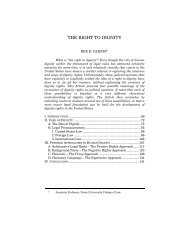A Right to Media? Lorie M. Graham - Columbia Law School
A Right to Media? Lorie M. Graham - Columbia Law School
A Right to Media? Lorie M. Graham - Columbia Law School
Create successful ePaper yourself
Turn your PDF publications into a flip-book with our unique Google optimized e-Paper software.
2010] A RIGHT TO MEDIA? 491<br />
Islander issues. 243 The centralized nature of this high profile<br />
committee is key <strong>to</strong> connecting the various indigenous communities<br />
across Australia, and promoting networking and resource sharing.<br />
Another important fac<strong>to</strong>r tied <strong>to</strong> the IPU is the recent<br />
establishment of the Cultural Pro<strong>to</strong>col, a set of guiding principles<br />
meant <strong>to</strong> assist non-indigenous journalists in their coverage of<br />
Aboriginal communities. 244 The comprehensive guide not only<br />
explains the culturally appropriate ways in which journalists should<br />
investigate and report on indigenous peoples or issues related <strong>to</strong><br />
Aboriginal and Torres Strait Islander communities, but it also<br />
discusses the relevance of this respectfulness both <strong>to</strong> good reporting<br />
and social harmony. 245 Respect is an extremely important fac<strong>to</strong>r in<br />
promoting and ensuring a right <strong>to</strong> media for indigenous peoples. It is<br />
also the primary focus of Article 15 of the UNDRIP, which seeks <strong>to</strong><br />
promote respect and <strong>to</strong>lerance among indigenous peoples and other<br />
segments of society through media sources.<br />
In terms of the recognition and promotion of indigenous<br />
peoples’ self-determining rights <strong>to</strong> develop and access media, there is<br />
the newly developed National Indigenous Television (NITV). In<br />
2005, after decades of advocacy and activism on the part of<br />
Aboriginal communities and media professionals, the Australian<br />
government agreed <strong>to</strong> support the development of National<br />
Indigenous Television (NITV) with $48.5 million in guaranteed<br />
funding until 2010. 246 NITV’s goal is <strong>to</strong> produce programming from<br />
an indigenous perspective. When NITV commenced transmission in<br />
July 2007, the service was receivable by an estimated audience of<br />
around 220,000 people, including viewers in Australia, New Zealand,<br />
and Papua New Guinea. 247<br />
243. Austl. Broad. Corp., About: Bonner Committee,<br />
http://www.abc.net.au/indigenous/about/bonner_committee.htm (last visited<br />
Feb. 5, 2010).<br />
244. Austl. Broad. Corp., Education: Cultural Pro<strong>to</strong>col,<br />
http://www.abc.net.au/indigenous/education/cultural_pro<strong>to</strong>col.htm (last visited<br />
Feb. 5, 2010) (highlighting an awareness that pro<strong>to</strong>cols for indigenous<br />
communities have been ignored by many media outlets and the Cultural Pro<strong>to</strong>col<br />
is meant <strong>to</strong> help the media <strong>to</strong> understand the importance of abiding by<br />
“Indigenous Pro<strong>to</strong>cols.”).<br />
245. Id.<br />
246. Nat’l Indigenous Television, His<strong>to</strong>ry, http://nitv.org.au/index.php?<br />
option=com_content&task=view&id=20&Itemid=12 (last visited Feb. 5, 2010).<br />
247. See Nat’l Indigenous Television, About Us,<br />
http://nitv.org.au/index.php?option=com_content&task=view&id=7&Itemid=46<br />
(last visited Feb. 5, 2010) (“The estimated audience of NITV will be















